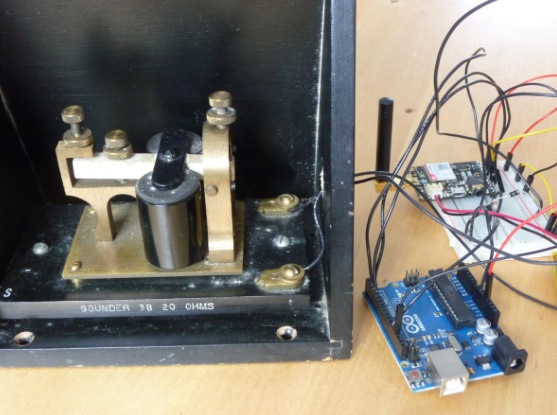25
Connecting a telegraph with 21st century networks
arduino, arduino uno, Featured, telegraph, twitter Comments Off on Connecting a telegraph with 21st century networks

Twitter telegraph is a project by Devon Elliot making telegraph sounder tap out Twitter messages using Arduino Uno. It’s an interesting attempt to connect technology rooted in the 19th- and early 20th-centuries with 21st-century networks:
A local architectural heritage project spawned a wider interest in railways and roundhouses. One of the related technologies of railways in the 19th century was the telegraph. Having acquired an old telegraph sounder, we wondered if it could tap out Twitter messages.
An Arduino UNO was used to test and control the telegraph sounder. The coils on the telegraph were tested with power drawn from the Arduino’s 3.3V and 5.0V pins. Momentarily powering the telegraph from the Arduino confirmed that the coils still worked, and the device made satisfying clicks in response from the electromagnetic action of the coils.
With it confirmed that the telegraph is still operable, the Arduino UNO was then used to control the sounder. Mark Fickett’s Arduinomorse library was a quick route to controlling the telegraph in Morse code timing. Using that library, string characters are converted into Morse code, and a digital pin on the Arduino goes high and low, as if to turn an LED on and off. That pin became the control pin for the telegraph, and simple circuit was built using a transistor, resistor and diode to control the telegraph without damaging the Arduino’s digital pins. This circuit is common for connecting relays to Arduinos.
The final step was adding an Adafruit FONA to the Arduino. The FONA connects to cellular phone networks, and the Arduino UNO can interact with it by sending and receiving actions to and from the FONA. In this case, the FONA connects to the cellular network and the Arduino checks the FONA periodically to see if there are any SMS messages available. If there are, the Arduino starts to read through them, convert them to Morse code, and tap them out on the telegraph.
The completed device can be operated from batteries if necessary, providing operation anywhere a cellular signal can reach. The cellular connection provides wireless connectivity with the FONA handling the connection, rather than the Arduino.
To package it up, the Arduino UNO and FONA were attached to a piece of acrylic. That board was then mounted under the telegraph sounder’s resonator. Four holes were pre-existing in the resonator’s base and used for mounting, so no permanent alterations were made to the historic components.
See it in action:



